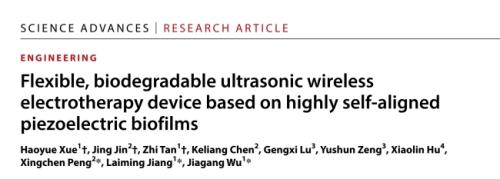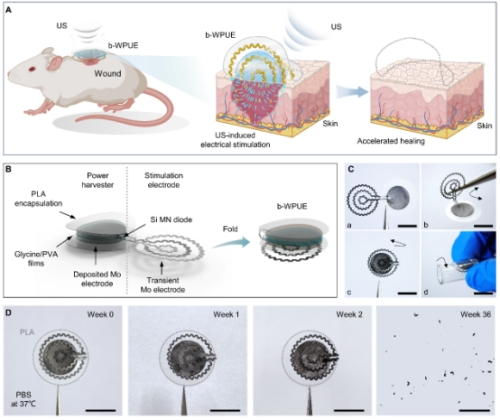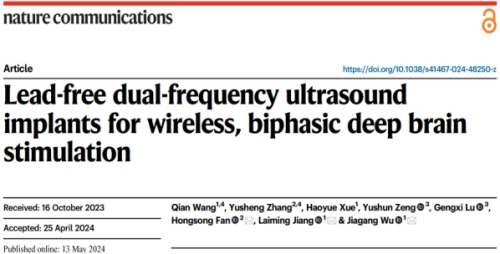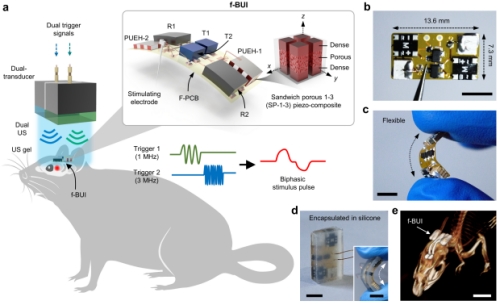Focusing onlead free piezoelectric materials + medicine, Jiagang Wu’s research team recently published their latest research papers titled“Flexible, Biodegradable Ultrasonic Wireless Electrotherapy Device Based on Highly Self-Aligned Piezoelectric Biofilms”and"Lead-Free Dual-Frequency Ultrasound Implants for Wireless, Biphasic Deep Brain Stimulation" in Science Advances and Nature Communications respectively. Sichuan University is the first signatory. Prof. Jiagang Wu and Laiming Jiang (associate research fellow) from theCollegeof Materials Science and Engineering at Sichuan University, Prof. Hongsong Fan from the NationalEngineering Research Center for Biomaterials, SCU, and Prof. Xingchen Peng from the West China Hospital, SCU are the corresponding authors.

Piezoelectric materials, known for their unique properties of converting mechanical energy into electricity and vice versa, are important functional smart materials for the preparation of such devices and have been integrated into numerous IWMS, including ultrasonic transducers, pressure sensors, and electrical stimulators. Because of the electromechanical properties of piezoelectric materials, they hold great potential for use in self- or wireless-powered bioelectronics, avoiding the use of capacity-limited and toxic chemical batteries that are usually required. Due to its good compatibility with biology, it is expected to be applied in medicine and promote the development of "materials + medicine".

Working principle and layouts of b-WPUE.

"Ultrasound-driven bioelectronics could offer a wireless scheme with sustainable power supply; however, current ultrasound implantable systems present critical challenges in biocompatibility and harvesting performance related to lead/lead-free piezoelectric materials and devices. Here, we report a lead-free dual-frequency ultrasound implants for wireless, biphasic deep brain stimulation, which integrates two developed lead-free sandwich porous 1-3-type piezoelectric composite elements with enhanced harvesting performance in a flexible printed circuit board. The implant is ultrasonically powered through a portable external dual-frequency transducer and generates programmable biphasic stimulus pulses in clinically relevant frequencies. Furthermore, we demonstrate ultrasound-driven implants for long-term biosafety therapy in deep brain stimulation through an epileptic rodent model. With biocompatibility and improved electrical performance, the lead-free materials and devices presented here could provide a promising platform for developing implantable ultrasonic electronics in the future." (Abstract)

Design and working principle of the f-BUI.
Jiagang Wu, a professor and doctoral student advisor, serves as the deputy editor of ACS Applied Materials & Interfaces and deputy director and secretary-general of the Dielectric Physics Professional Committee of the Chinese Physical Society. His research area is high-performance lead-free piezoelectric ceramics and devices.
Laiming Jiang, an associate research fellow and master student advisor. His research focus is the development of high-performance piezoelectric materials and their devices. He has published multiple papers in international high-level journals such as Sci Adv, Nat Commun, Adv Mater, and Prog Mater Sci.
Hongsong Fan is a professor at the National Engineering Research Center for Biomaterials of Sichuan University. Being a doctoral student advisor and expert who receives special allowances from the State Council, he focuses on tissue regeneration biomaterials and tissue engineering, as well as nano-biomaterials and flexible neural electrode interfaces. He has published multiple papers in high-level journals such as Nat Commun, ACS Nano, and Small.
Xingchen Peng, a professor at the West China Hospital of Sichuan University, doctoral student advisor, and young scholar of the Ministry of Education's Important Talent Program. He is mainly engaged in comprehensive treatment of malignant tumors, including radiotherapy, chemotherapy, targeted therapy, and immunotherapy. The research and development achievements have won the second prize of Sichuan Province Science and Technology Progress Award (the first author).
The research work was funded by the national Science Foundation of China (NSFC) (grants U23A20567 and 52202144), and the Engineering Characteristic Team Project of Sichuan University.
https://www.science.org/doi/epdf/10.1126/sciadv.adn0260
https://www.nature.com/articles/s41467-024-48250-z
